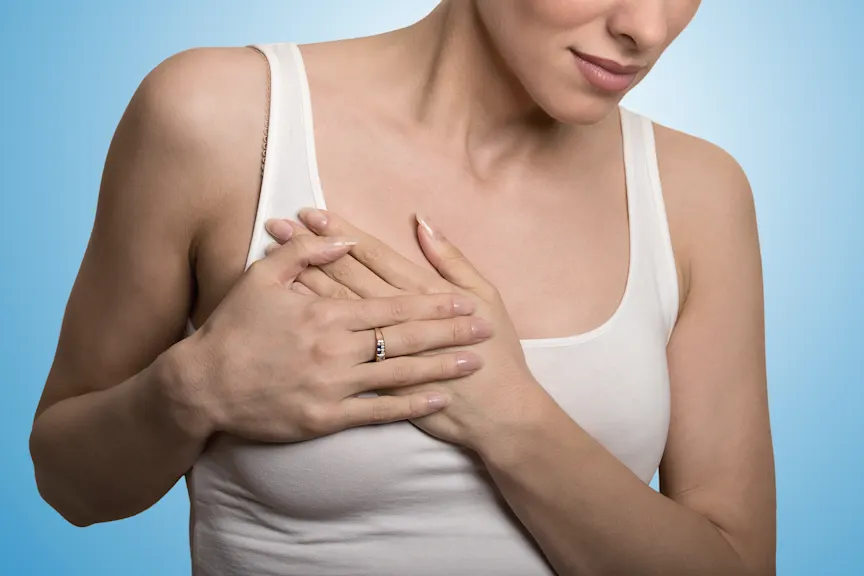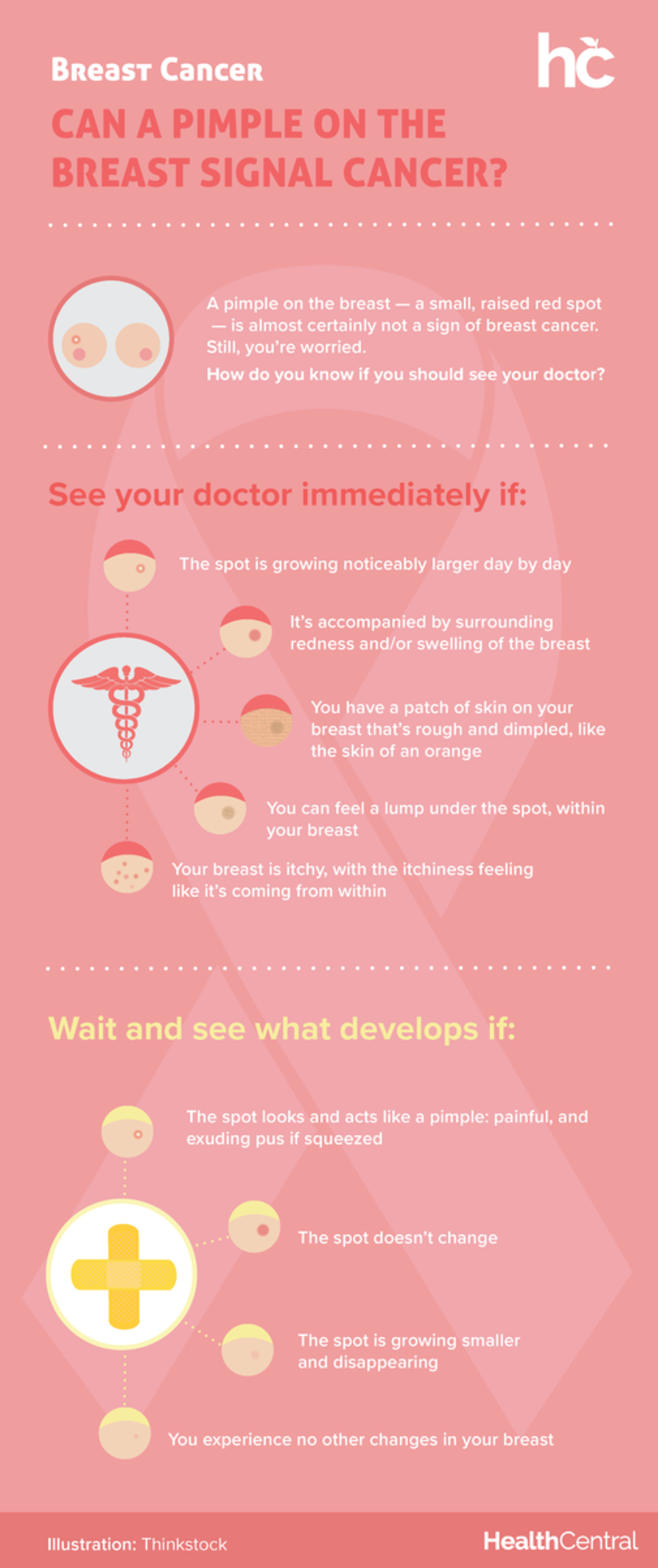Pimples on Breasts: Causes, Treatment, When to See a Doctor - Health Central
Could that small bump be a sign of breast cancer? Probably not—but here's what it might mean.

You're taking your bra off at the end of the day when you notice it: a small, red spot on your breast. It looks like a pimple, but you're not sure—is breast acne even a thing? Or could this be a sign of something more serious, like breast cancer?
Let's cut to the chase for a little peace of mind: Pimple-like marks on the breast are usually just that—pimples. "We often say, 'common things are common,'" says Danika Forgach, M.D., an OB-GYN at UCHealth Women's Care Clinic in Greeley, CO.
So what might be causing the pimples on your breast? Let's take a deeper look at possible explanations and explore whether red spots on the breast are ever symptoms of breast cancer.
Breast Acne Causes
Acne—like the little dots your get on your back or face—is the most likely culprit for the spots on your breast. "The skin of the breast is similar to skin anywhere else, so just like you can get a pimple anywhere else on the skin, it's very common that you can get them on the breast, too," explains Dr. Forgach. And just like acne on other parts of your body, breast acne is likely due to one of four things: Oily skin, clogged follicles, inflammation, or bacteria on the skin surface.
Other factors contribute to breast acne, including hormonal changes, stress, diet, and certain medications, according to the Mayo Clinic. What's more, friction between skin and other material (say, the fabric of your clothes) can exacerbate breast acne. For that reason, women who exercise frequently may be more prone to breast acne, as sweat combined with form-fitting clothing can cause the outbreak.
Other Causes of Breast Pimples
There are other explanations for acne-like bumps on your breasts, says Stephanie Fine, M.D., a breast surgical oncologist at University of New Mexico Comprehensive Cancer Center in Albuquerque, NM. These are several common ones:
Folliculitis
Folliculitis is a condition that occurs when the hair follicles (yes, you have hair on your breasts or nipples) become irritated. This irritation appears as one or several red bumps. "A little hair follicle can get inflamed, for example, if you've been tweezing or shaving the area," explains Stephanie Mager, M.D., also an OB-GYN at UCHealth Women's Care Clinic in Greeley, CO.
Yeast Infection
Believe it or not, yeast overgrowth—often associated with vaginal discomfort—can occur on other areas of your skin, too, including your breasts. This causes a reddish rash or pimple-like spots, typically found in the crease area underneath the breast itself, says Dr. Fine. To prevent yeast overgrowth, focus on keeping the area dry (another reason why these rashes may be more common if you sweat a lot or play sports). If a yeast infection does occur, head to the doctor for an antifungal cream or oral pill.
Bug Bites
Yes, a mosquito or spider could have found its way to your breast and left a mark. You'll be able to tell the difference between acne and a bug bite first and foremost by the itch factor: If you're scratching, bug bites are the likely suspect. Which bug? Fleas often leave small red bumps in groups of three, while mosquito bites usually appear as puffier red or white bumps. Spider bites appear as a single red swollen bump (although there may be more than one bump if the spider bites you more than one time). The skin is typically more painful than itchy.
There are other benign, but less common, causes of changes to the skin on your breast. "If it's a bigger spot that continues to grow in redness, or it has pus growing out of it, that can be an abscess, and that's definitely something to get looked at," Dr. Mager says. These are caused most often by skin infections but can also occur in the postpartum period in some women who develop mastitis (inflammation of the milk ducts of the breast). Abscesses are usually treated with antibiotics, and some may need to be drained by your health care provider, says Dr. Mager.
Other potential causes of noncancerous bumps or "pimples" on the breast include things like psoriasis, eczema, or allergic reactions, according to the American College of Obstetricians and Gynecologists.
Telling the Difference Between Breast Cancer and Pimples
Breast pimples are virtually never a sign of breast cancer. Still, there are certain skin changes, called lesions, on the breast that may be cause for concern. "The most important feature to distinguish between cancer and benign problems is the history of a lesion," explains Dr. Fine. "Benign lesions change over time, usually resolving, like most pimples that eventually drain and then disappear."
Lesions associated with cancer, however, are persistent. "They do not go away despite a few weeks of watching," she adds. If you have small raised or red spots on your breast that are not improving after several weeks, a trip to the doctor for examination is a good idea.

Inflammatory Breast Cancer Red Spot
Inflammatory breast cancer (IBC) is a rare and aggressive form of the disease where instead of tumors forming a lump, the cancer cells block lymph vessels in the skin and prevent fluids from leaving the breast. In turn, this fluid buildup causes the breast to swell and become red, according to the MD Anderson Cancer Center.
Thankfully, inflammatory breast cancer is quite rare, accounting for only 1% to 5% of all breast cancer cases, according to the American Cancer Society, and a regular pimple is not a sign of this kind of cancer. Still, you'd hardly be the first to worry. "Many people mistake a localized red spot, like a pimple or a bug bite, for inflammatory breast cancer," says Dr. Fine.
You can tell the difference by watching for certain types of skin changes. "With inflammatory breast cancer, it's typically not a small pinpoint like a pimple is," says Dr. Mager. "It's more of a generalized redness and swelling of a larger area of the breast that can spread and get worse pretty quickly." Dimpling of the skin (giving the appearance of an orange) is another sign of IBC.
Any quarter-sized area of redness on the breast—or any of the above symptoms—should be evaluated by a doctor, says Dr. Fine (as should any lump or mass felt under the skin of the breast). "Typically, if there is any suspicion that this could be a cancer, diagnostic imaging consisting of a mammogram and ultrasound are ordered by the provider and are the first step," says Dr. Fine. "The second step might be a needle biopsy of the breast finding."
Breast Acne Treatment
So, say you've determined that the pesky red spot is really just a pimple. Or maybe you're experiencing more severe breast acne. What can be done? "The same things that you do for acne anywhere else on your body, you can do for acne of the breast," says Dr. Forgach. "If you have really significant acne of the breast, oral medications or topical medications may be appropriate."
Treatment also depends on how severe the acne is, Dr. Forgach adds. For example, one or two pimples here and there are not likely something that needs medical treatment, but more severe cases may warrant medication. "And something like cystic acne of the breast can be really uncomfortable, so that would be something we would talk about in the office," she says.
For milder cases of breast acne, these tips can help you find relief at home, according to the American Academy of Dermatology Association:
Wash your skin with a gentle cleanser and rinse with lukewarm water to help keep acne at bay. Do this twice a day and after any sweat session.
Avoid scrubbing the skin of the breast, which may irritate it more. Also skip any exfoliants or products that may increase irritation, like scented lotions.
Resist the urge to squeeze or pop your pimples. It's best to let things clear on their own because picking or popping can delay healing and increase your risk of scarring.
When to See a Doctor
Larger areas of redness and swelling or dimpling of the skin around your breast are potentially signs of something more serious, so it's best to schedule a doctor's appointment right away.
But if you're seeing just a small pimple-like spot, keep an eye on it for a week or two—it may go away on its own. Still there? "Persistence of any red lesion for over four weeks without resolution, drainage, or decreased prominence should prompt a visit to the primary care provider," says Dr. Fine.
The bottom line? A pimple-like spot on your breast is highly unlikely to be something serious. But if your anxious brain is startin to think the worst, it's always OK to call your doctor's office for a check-up.




Comments
Post a Comment